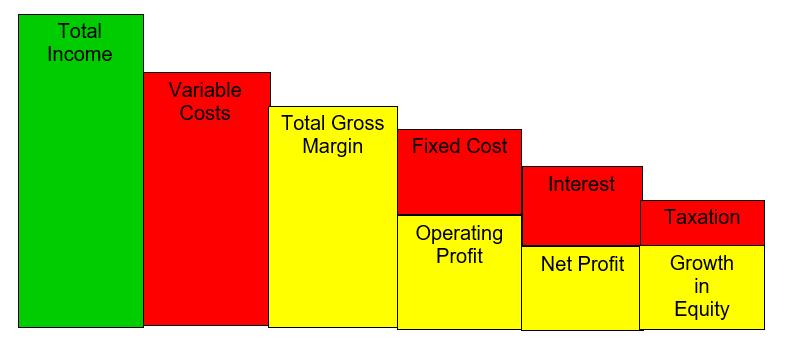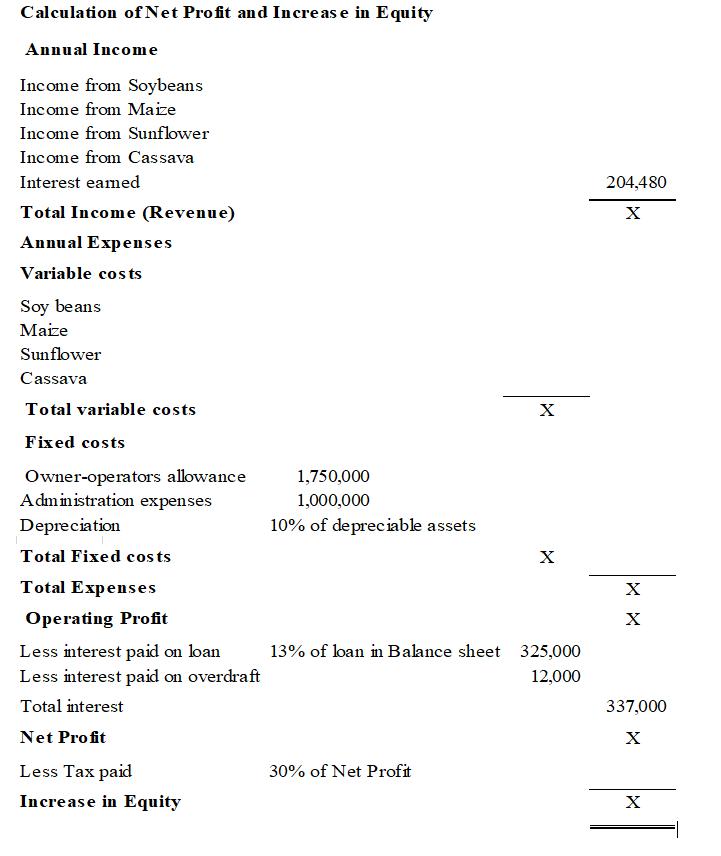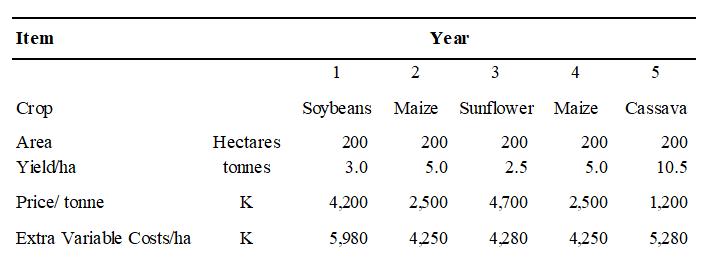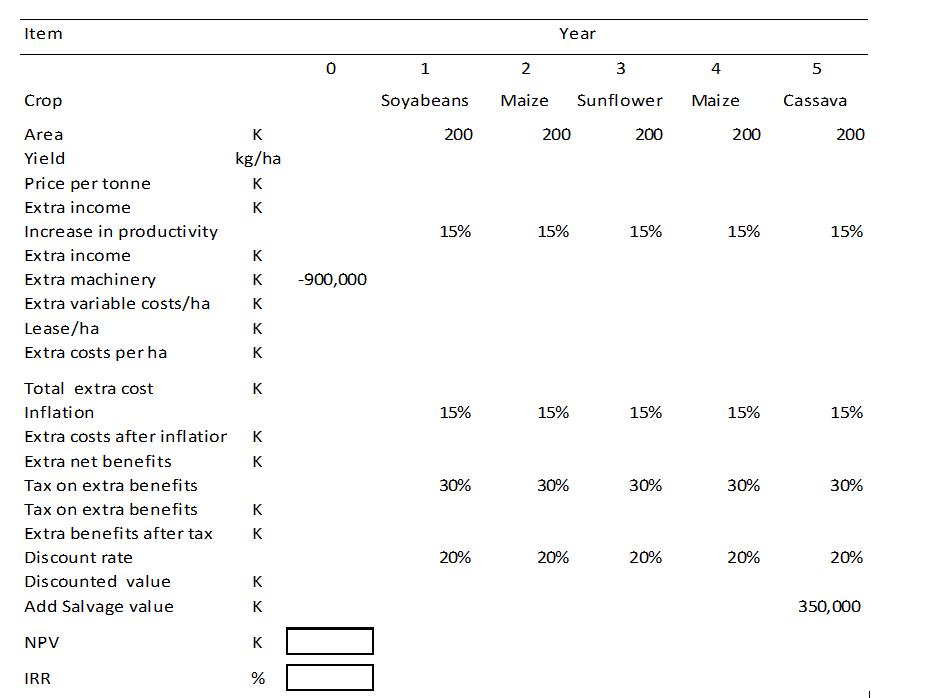Question
The Maambo family own a farm at Kabwe in the Central Province. The farm is 800 ha. The farm is valued at K 9,000,000. The
The Maambo family own a farm at Kabwe in the Central Province. The farm is 800 ha. The farm is valued at K 9,000,000. The assets for the farm at the start of the year include depreciable assets of K 1,440,000 and cash of K 1,000,000. Their liabilities are a bank loan of K 2,500,000. During the year they make a loan repayment from the bank loan of K 250,000. Interest paid on the bank loan is K 325,000. Interest on an overdraft was K 12,000
a. Construct a Balance Sheet for the Maambo family at the start of the year.
The farm is involved in cropping. They grow a rotation of Soybeans, Maize, Sunflower, another crop of Maize finishing the rotation with a crop of Cassava.
Details for the cropping system:

b. Calculate total income and total variable costs for each of the above crops.
The deduction from gross income and total variable costs to arrive at Operating Profit, Net Profit then Growth in Equity over a production period of one year for the Maambo’s farm business are displayed in the following figure.

c. Calculate Operating Profit, Net Profit and Growth in Equity over one year for the Maambo Family’s Farm business.
Note that apart from income on crops, the Maambo family also earned interest of K 204,480 on their bank balance at the beginning of the year.

d. Calculate Annual Net Cash Flow and amount of Cash for the Balance Sheet at the end of the year.
Note: The Cash Flow Budget does not contain an amount for depreciation because it is an allowance, not a cash cost. Further, it does include an item for reduction of loan at the beginning of the year because it is an amount paid from Net Profit.

c. Construct a Balance Sheet for the Maambo family at the end of the year.
Note: The difference between Equity in the Balance Sheet at the start of the year and the Equity in the Balance Sheet at the end of the year must be the same as the Increase in Equity calculated for Operating Profit, Net Profit and Growth in Equity over the year of production.
There are three main things that business people who manage farms wish to know. First, has the equity in their business grown over the year. What has been the efficiency of their farming operation? That is determined by dividing the Operating Profit by the average value of their total farm assets over the year. Third, has there been an increase in their holding of cash at the end of the year?
Calculate those parameters and comment on their relative value.
Also calculate the gearing ratio (liabilities divided by the equity in the balance sheet at the end of the year). Comment on its value in terms of the measurement of risk for the Maambo Family’s farm business.
d. Discounted Cash Flow
You will understand that to obtain a sum of money now instead of in the future is important. This is because when you get money in the present time you could invest it at a particular interest rate. The amount of money would grow into the future.
Say that you were promised an amount of money and that it was worth K 10,000 now. You are given the option of receiving it in 5 years into the future. You know that you could invest it now a current rate of interest of 10 per cent per annum. If you waited for 5 years the amount that you would receive would be less at K 6,209.21.
The same process is involved in investment analysis. To get an idea of what a future stream of cash was worth as a lump sum today you would have to calculate its Net Present Value. This can be achieved by applying the following equation.

Where:
∑ = Sum of
Ct = Net cash inflow for the period t
Co = the initial investment
r = the discount rate
t = the number periods (years)
Note that NPVs are an assessment of wealth.
It is a common experience for commercial farmers to increase their wealth by renting land rather than by purchasing it. The reason is that they obtain economies of scale. That is, the extra land will attract a rental fee, but the overhead or fixed costs will be held to a minimum.
The Maambo Family have been offered the rental of 200 hectares of land that borders their farm. The amount of annual rent will be K 6,250 for 10 years.
The Maambo Family want an earning rate on capital invested of 20 % per annum. That is, the discount rate will be 20% per annum.
They will have to invest on day one an extra K 900,000 for machinery. The salvage value at the end of year 10 has been estimated at K 350,000. That amount is not discounted. b. That is, depreciation is not a fixed expense.
Five years of the rotation repeated for a further five years are shown below. Also displayed are yields per hectare for the various crops with estimated prices per tonne and extra variable costs.

All items are in nominal values that include inflation. Extra income is per annum is multiplied by a productivity increase of 15% per annum. Inflation is also 15% per annum per annum charged on total extra cost per annum to get extra costs after inflation.
Calculate NPV and IRR for the investment analysis and comment on the Maambo Family’s decision to carry out the investment.
See attachment for the layout as an Excel spreadsheet.

The value of the extra NPV is equal to the sum of the annual discounted value of extra net benefits after inflation plus the salvage value of machinery.
Crop Hectare Yield/ha Price/tonne Variable costs/ha Tonnes K K Soybeans 160 3.0 4,000 5,980 Maize 320 4.5 2,000 4,250 Sunflower 160 2.5 4,500 4,280 Cassava 160 10.5 1,200 5,260
Step by Step Solution
3.49 Rating (172 Votes )
There are 3 Steps involved in it
Step: 1
A BALANCESHEET OF THE MAAMBOO FAMILYAT THE BEGINING OF THE YEAR LIABILITIES AMOUNT ASSETS AMOUNT BAN...
Get Instant Access to Expert-Tailored Solutions
See step-by-step solutions with expert insights and AI powered tools for academic success
Step: 2

Step: 3

Ace Your Homework with AI
Get the answers you need in no time with our AI-driven, step-by-step assistance
Get Started


